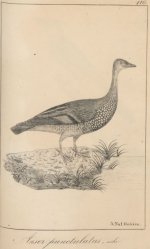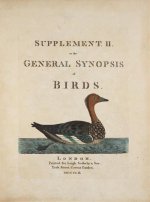Or maybe the question should be why there is no Anatiformes?
There are no rules of priority applying to order names in animals, and no universal rules saying how to form them. In birds the modern orders names are indeed conventionally formed in such a way that they "look like" they are made of a generic stem to which a suffix "-iformes" was added; but in many other groups (e.g., insects, mammals), orders have arbitrary names that are not related to generic name in any way. I believe we have "Anseriformes" because Linnaeus 1758 had "Anseres" for one of his original orders, and this happens to have sticked -- except for the "-iformes" thing that was added when it became fashionable. Linnaeus' Anseres was merely the Latin word
anser (goose) in the plural; not a generic name (the genus
Anser Brisson 1760 did not exist yet in 1758; Linnaeus 1758 placed geese in
Anas). Ditto for "Galliformes", which seems more likely to me to derive from Linnaeus' order name Gallinae (the plural of
gallina, a hen), rather than the generic name
Gallus (also of Brisson 1760; Linnaeus 1758 called the fowl
Phasianus gallus).
According to Bock's History and Nomenclature of Avian Family-Group Names (fussy hyphen, that), both Mergidae and Anseridae enjoy priority over Anatidae, but (p. 173) "Anatidae Leach 1820 should be conserved conditionally in preference to Mergidae and Anseridae because of its well-established use for 170 years since the original proposal of the name Anatidae."
Bock's work is problematic...
Anatidae:
My current preference:
Anatidae; family; Leach WE. 1819. Eleventh room. Pp. 63-68 in: Synopsis of the contents of the British Museum. Fifteenth Edition. British Museum, London.; p. 67;
https://books.google.com/books?id=YSlhAAAAcAAJ&pg=PA67
(This edition was not cited by Bock 1994. The 14th ed. had no names in it
https://books.google.com/books?id=WylhAAAAcAAJ&pg=PA62 ; the 16th edition
https://books.google.com/books?id=ZylhAAAAcAAJ&pg=PA63 had a reworked text, but the same names as in the 15th ed. Bock only cited the 17th ed.)
Bock 1994 accepted:
Anatidae; family; Leach WE. 1820. Eleventh room. Pp. 65-68* in: Synopsis of the contents of the British Museum. Seventeenth Edition. British Museum, London.; p. 68*;
https://www.biodiversitylibrary.org/page/55257931
(A year, and two eds, later than Leach 1819.)
Anserinae:
My current preference:
Anserides; family; Goldfuß GA. 1820. Handbuch der Zoologie. Zweite Abtheilung. Johann Leonard Schrag, Nürnberg.; p. 198;
https://books.google.com/books?id=aPN8cFZ-XhQC&pg=PA198
(Goldfuß' system for birds was Illiger's with a couple of changed/added names, most of which were formed from generic names and have no reasons to be unavailable. This work was not cited by Bock 1994.
Anser is attributed here to Meyer, which would be
http://biodiversitylibrary.org/page/42446119 ; but Meyer obviously picked it from Brisson, to whom he attributed the first binomen in which he used the name.)
Bock 1994 accepted:
Anserina; subfamily; Vigors NA. 1825. Observations on the natural affinities that connect the orders and families of birds. Trans. Linn. Soc. London 14: 395-517.; p. 404;
https://biodiversitylibrary.org/page/27490748
(Five years later than Goldfuß.
Additionally, Bock regarded this name as being in wide use and as having replaced, before 1961:
Anserinia; subfamily; Rafinesque-Schmaltz CS. 1815. Analyse de la nature, ou tableau de l'univers et des corps organisés. S.n., Palerme.; p. 72;
http://gallica.bnf.fr/ark:/12148/bpt6k98061z/f75.image .
...due to the type genus of the latter,
Anseria Rafinesque, having been made a synonym of Anser Brisson 1760: in this case, Vigors' name should take precedence from from the date of publication of the relaced name (i.e., 1815) under
Art. 40.2. But Rafinesque's family and subfamily names were explicitly not plural
https://gallica.bnf.fr/ark:/12148/bpt6k98061z/f39.image , thus fail to meet
Art. 11.7.1.1, are principle wholly unavailable, and have no precedence to pass to a later name. (
Anseria Rafinesque 1814 is a new name for (or emendation of)
Anser Brisson, deemed to conflict with
Cancer Linn. 1758 under Rafinesque's peculiar nomenclatural rules:
https://books.google.com/books?id=Op85AAAAcAAJ&pg=PA27 . Bock attributed this name to Rafinesque 1815, where it would have been wholly nude, leaving the family name he nevertheless accepted nude as well.))
Mergini:
My current preference:
Merginae; stirps; Fischer G. 1831. Rapport aux membres de la Société sur quelques faits nouveaux en zoologie. Oiseaux. Bulletin de la Société Impériale des Naturalistes de Moscou, 3: 57-85.; p. 85;
http://biodiversitylibrary.org/page/40206798
(This work not cited by Bock.)
Bock 1994 accepted:
Mergidia; subfamily; Rafinesque-Schmaltz CS. 1815. Analyse de la nature, ou tableau de l'univers et des corps organisés. S.n., Palerme.; p. 72;
http://gallica.bnf.fr/ark:/12148/bpt6k98061z/f75.image
(Earlier than Fischer, but Rafinesque's family and subfamily names were explicitly not plural
https://gallica.bnf.fr/ark:/12148/bpt6k98061z/f39.image , thus fail to meet
Art. 11.7.1.1, and are in principle wholly unavailable.)
(Note also:
Mergidae; family; Leach WE. 1819. Eleventh room. Pp. 63-68 in: Synopsis of the contents of the British Museum. Fifteenth Edition. British Museum, London.; p. 67;
https://books.google.com/books?id=YSlhAAAAcAAJ&pg=PA67
This edition (and this name) not cited by Bock. For grebes, loons, shearwaters and auks, while mergansers were in Anatidae: the type here was not
Mergus Linnaeus 1758, but its junior homonym
Mergus Brisson 1760, which is an invalid synonym of
Gavia (cf. also Leach in Ross 1819:
https://books.google.com/books?id=GEsNAQAAIAAJ&pg=PA159 , where he attributed this name to Brisson). Senior homonym of Merginae Fisher 1831, but permanently invalid (based on a junior homonym), and was certainly not used after 1899.)
Based on the above, I would say that Anatidae has precedence over both Anseridae and Mergidae, and the only name that should be conserved conditionally is Merginae Fischer (relative to Mergidae Leach).
PS - "family-group names" are names of taxa belonging to the family group, which encompasses all taxa ranked from above the genus, up to the superfamily. The hyphen may look fussy from the outside, but it's pretty standard nomenclatural jargon (> 100 instances in the Code).








